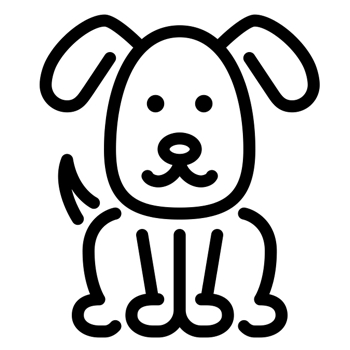Lab-Pointer

A mix breed that was likely developed several decades ago, the Lab-Pointer was created by breeding the much-loved Labrador Retriever with the sporty Pointer. Retaining the sweet nature of both its parents, the Lab-Pointer has come to be known for its kind-hearted nature and ability to play gently with children of all ages.
A medium to large-sized dog, the Lab-Pointer has a densely-built body with good muscling and long limbs, providing it with plenty of speed and endurance. Never one to shy away from any activity on offer, this breed loves to be out and about with the family and particularly enjoys long hikes and play time with the kids.
About & History
What do you get when you cross a Labrador Retriever with a Pointer? The answer is a well-balanced, sweet-tempered and energetic breed known as the Lab-Pointer. The Labrador Retriever, one of the most internationally famous breeds of all time, started from humble beginnings, working along the shores of Canada in the 1800s, providing a helping hand to the local fishermen.
The Pointer originated in the Iberian Peninsula around 500 years ago, where he was used as a hunting dog, excelling at both tracking and pointing. With both of its parents coming from hard-working stock, the Lab-Pointer is not one to shy away from hard graft (or good old-fashioned play either, for that matter).
While its exact date of origin is undetermined, the Lab-Pointer is thought to be one of the original ‘designer dogs’ and has likely been around for at least three decades. As both the Labrador and the Pointer are very common dog breeds, it is quite probable that Lab-Pointers were being produced independently of each other in several locations around the world at the same time.
While both the Labrador Retriever and the Pointer are part of the AKC’s Sporting Group, the Lab-Pointer (alongside other cross-breeds) is not yet officially recognised by any mainstream kennel club. Today, Pointer-Lab mixes are seen all the time around the world and make a wonderful family pet.
Appearance
As with other hybrids, the initial litter produced from a Labrador and a Pointer can have a varied appearance, though physical traits become more pronounced through each mating. Typically, a Lab-Pointer is a well-built dog of a medium to large size that has good muscling and a supple gait. Their wide head is square in shape and possesses endearing brown, hazel or amber eyes and a large nose that may be either brown, black or beige. Their medium-length ears flop over and lie close to their head, while their muzzle is moderately-sized. The body of the Lab-Pointer is compact and strong, supported by long, lean limbs. Their tail is quite chunky at the base and will reach beyond the hocks when held down.
The double-coat of the Lab-Pointer tends to be thick and short. As its ancestors were made to swim, its coat is also water-proof. The fur of this breed sheds moderately and may be brown, white, cream or black. Many dogs will be black with a large white patch on their chest and other white markings. Adult dogs will weigh between 55 and 80 pounds and measure from 21 to 28 inches, with females weighing and measuring slightly less than their male counterparts.
Character & Temperament
Both the Pointer and the Labrador Retriever are known for their good-natured personality and friendly temperament. Mixing them together only serves to bring out this sweet and loving character even more. Mild-mannered and considerate, the Lab-Pointer makes a great pet for people of all ages. Dedicated to those it loves, it shows fierce loyalty towards its family, though is not hostile enough to be used as a guard dog. This breed can, however, be used as a very effective watch dog and will always bark loudly at the first sign of any new arrival to the home.
Unlike many other affectionate breeds, the Lab-Pointer does not tend to become over-reliant on its owner and separation anxiety is not frequently seen as an issue in this independent canine. Happy in its own company, as well as when with humans and other animals, the Lab-Pointer is a well-rounded dog that is easy-going and easy to please. A good friend to most animals, care should be taken if around smaller pets, such as rabbits, as the Pointer’s natural hunting tendencies may prove too strong for the Lab-Pointer to ignore.
Trainability
Generally thought of as a breed that is straightforward to train, this is a good option for first-time owners with limited experience of dogs but plenty of time on their hands and a keen interest in training. The intelligence and willingness of the Lab-Pointer go hand-in-hand (or perhaps paw-in-paw!) to create a wonderful student.
One area in which the Lab-Pointer can struggle is concentration. While they enjoy participating in training sessions and tend to do well in them, their attention can wander, particularly if the training occurs outdoors near wildlife. Keep sessions short and interesting and spend a good amount of time working on recall.
To avoid a timid adolescent Lab-Pointer growing to be a fearful adult, plenty of time should be spent on building up their confidence and exposing them to a variety of scenarios. Given time, this breed will soon come out of its shell and can make a sociable playmate in the dog park.
Health
Though it is more of a challenge to predict health issues in new, hybrid breeds, we can look to their predecessors to predict the conditions that are most likely to afflict them. In particular, we should be on the lookout for:
Hip & Elbow Dysplasia
Common ailments of larger-sized dogs, hips and elbows that do not form properly can lead to life-long problems of stiffness and reduced mobility. As imaging can easily identify the existence of these issues, any dog to be used for breeding should be screened for joint dysplasia before being mated.
Bloat/Gastric Torsion
While experts disagree on the cause of bloat, some feel it may be caused by excessive exercise after eating a large meal. Due to this, many owners won’t allow their dog out straight after eating. Some owners will also use ‘slow-feeder bowls’, which can reduce the tendency to bolt food too quickly.
Symptoms of bloat include an enlarged abdomen, a restless dog and excessive panting and retching. Immediate veterinary care is required to give an affected dog the best chance of survival.
Hypothyroidism
An underactive thyroid can result in a myriad of symptoms and may prove challenging to diagnose. Symptoms can be subtle and often include weight gain, sluggishness, heat-seeking behaviour and chronic skin infections. A blood test can help diagnose the condition and it can be well-managed with life-long medication in the form of tablets.
Obesity
While obesity itself is not a ‘disease’ per se, it can dramatically reduce the quality of life of an animal and can lead to the development of a huge number of medical conditions, including diabetes, heart disease and some cancers.
Recent studies have demonstrated an undeniable genetic propensity for the Labrador Retriever to become overweight. Obesity can be avoided by providing the correct number of calories and adequate exercise every day.
Exercise and Activity Levels
A sporty dog, the Lab-Pointer requires ample exercise to keep it in good shape and both physically and mentally satisfied. Bringing them on walks alone can be under-stimulating and they would much rather play games, track and scent or go for a refreshing swim. Variety really is the spice of their life and the more wide-ranging the activities offered to them, the happier a Lab-Pointer will be.
Given the Lab-Pointer’s superb sense of smell and high prey drive, extreme care must be taken when exercised off the lead as even a dog with good recall can be impossible to call back if they catch the scent of a tempting squirrel nearby. An adequately big house and a large garden can go a long way towards keeping the Lab-Pointer occupied in between outdoor activities.
Grooming
The coat of the Lab-Pointer tends to fall somewhere in between the short fur of the pointer and the thick coat of the Lab. Grooming is quite low maintenance and consists of a good brushing every few days and a thorough ear cleaning a few times a month. The claws of the Lab-Pointer are often thick, though running on hard ground can help to keep them filed down.

